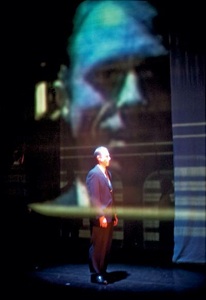2nd Thoughts on the 4th Wall
As part of my Naturalist project, I'm trying to think again about all the most basic and obvious components of that theatre movement to see if there may be greater complexity lurking in there. For this talk, I wanted to look at the 'fourth wall'. The term was coined by the playwright and critic Jean Jullien in his book Le Théâtre Vivant (1892) where he discusses 'un quatrième mur transparent pour le public, opaque pour le comédien' (p 11). The idea is that the proscenium edge of the stage is an invisible wall that the audience can see through, but which the actors must imagine is there. It abolishes any direct acknowledgement of the audience, dramaturgically (through asides, soliloquies, etc.) or directorially (Antoine famously acted with his back to the audience).
But what is this wall? What did it mean? What - culturally, politically, philosophically - is this wall made of? Can we look at this invisible wall? Does the invisible 4th wall have content?
In this paper - the beginning of a longer investigation - I come at the question from a number of directions: I look at the iconography of another means of seeing through a wall: windows in art, from German romanticism to Naturalism; I then look at the histories of domestic architecture under the Second Empire; finally I look at the political imaginary (to use Kristin Ross's term) of the Paris Commune, with an aside about Gordon Matta-Clark. test
Particular thanks go to Mark Robson and Elodie Laügt for their generous invitation and hospitality.



![photo[1].jpg](https://images.squarespace-cdn.com/content/v1/513c543ce4b0abff73bc0a82/1362919072201-PZO854G4SEB794DVOEI8/photo%5B1%5D.jpg)
